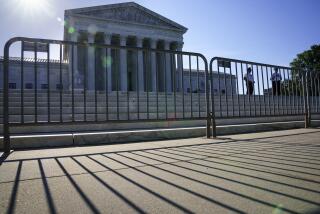Op-Ed: Battling over Neil Gorsuch is beside the point: The Supreme Court needs an institutional overhaul
President Trump nominated Neil M. Gorsuch as the next Supreme Court justice Tuesday, and Senate Democrats are already lined up to oppose the nomination. Despite the super-heated political rhetoric, the nomination of another conservative jurist to replace Justice Antonin Scalia wonât move the courtâs center of gravity. If Trump wants to have a lasting effect on the law, he should be working with the Republican Congress to make changes in â not on â the Supreme Court.
As an institution, the nationâs highest court is anachronistic, dysfunctional and long-overdue for an overhaul. Real change could be accomplished with just three basic reforms.
First, the court is too small. When the first Supreme Court convened in 1790, at the Royal Exchange Building in New York City, only two of the then six-member court showed up. For many years, the size of the court was set by the number of âcircuitsâ â the regional appellate courts in the country. In 1869, that number was nine. While we currently have 13 such circuits, the court remained frozen at nine justices.
We never have had a national debate on the ideal size of this key institution, but we can be certain nine isnât it.
We never have had a national debate on the ideal size of this key institution, but we can be certain nine isnât it. That configuration concentrates authority in too small a group. Indeed, it is often in the hands of only one person â the perennial problem of the âswing justiceâ on a divided court. For years, the court was effectively just Sandra Day OâConnor. Now, Anthony M. Kennedy plays the swing role.
A better size is 19. The increase could occur slowly with no president filling more than two new positions per term. That would bring the U.S. high court in line with those of other countries, which have purposefully avoided our courtâs concentration of power (and swing justice) problems. Germanyâs high court has 16 members; Japanâs, 15; the United Kingdomâs, 12; Indiaâs, 31; and Israelâs, 15.
On a 19-member Supreme Court, two justices (rotated by order of seniority) would sit each year on lower courts â a tradition from the early days of the Republic that should be resumed. When âriding circuitâ was abandoned, it produced a Supreme Court too easily seen as arrogant and out of touch with real-world issues.
A larger court would also give more presidents more nominees and give the court a greater diversity of views. A larger court might even reduce our continual confirmation spasms whenever one of the few positions becomes vacant. And with more seats to fill, the quality of the jurists might rise.
Although it seems counterintuitive, seats on the court come up so rarely now, and are so contentious, that presidents often pick nominees who are not particularly outstanding or distinctive in their field in order to make confirmation easier. A larger court would decrease each justiceâs power, but it would probably increase the high courtâs overall expertise.
Next, cameras should be allowed into the Supreme Court. The framers were such great believers in the need for justice to be done in public that they put it into the Constitution. The 6th Amendment guarantees public trials, and yet the justices currently make people wait in line (the wealthy hire line âsittersâ) for days to get one of the relatively small number of seats in the courtroom. In an effort to fend off cameras, the court agreed in 1999 to release audio, in addition to transcripts, in some cases. That has simply made the situation more bizarre â itâs as if the courtâs communication technology stopped with the advent of radio.
The objection some justices have made to video isnât that the lawyers will grandstand, but that their fellow justices will. In 2007, Justice Kennedy suggested that if the proceedings were televised it would be âhuman nature for me to suspect that one of my colleagues is saying something for a soundbite.â
Protecting justices from temptation is hardly a compelling argument for denying the public access to their highest court. Congress should order the cameras to start rolling, and any judges who feel they must retire should be thanked for their service.
Finally, the Supreme Court is not just an island protected from modern technology but also judicial ethics. With self-serving logic, the justices insist that they alone can judge their conduct. They have voluntarily agreed to âreferâ to the Code of Judicial Conduct for guidance. Often it appears to be honored primarily in the breach. Justices have given public speeches in which they have discussed pending issues and cases, attended political fundraisers, and ruled in cases where they or their spouses have financial interests.
Congress should require the Supreme Court to adopt a formal code of ethics, including a process by which citizens can file complaints against justices. In the Federalist Papers, James Madison observed that âno man is allowed to be a judge in his own cause.â However, the nine justices on the Supreme Court demand precisely that unilateral power when it comes to their behavior.
Jonathan Turley is a constitutional law professor at George Washington University.
Follow the Opinion section on Twitter @latimesopinion and Facebook
MORE FROM OPINION
How California can fight the extreme provocations of Donald Trump
Jeff Sessions isnât the attorney general we need
Question for Democrats: Is Gorsuch illegitimate or extreme?
When the GOP stole Merrick Garlandâs Supreme Court seat, they set the stage for a miserable battle
More to Read
A cure for the common opinion
Get thought-provoking perspectives with our weekly newsletter.
You may occasionally receive promotional content from the Los Angeles Times.










